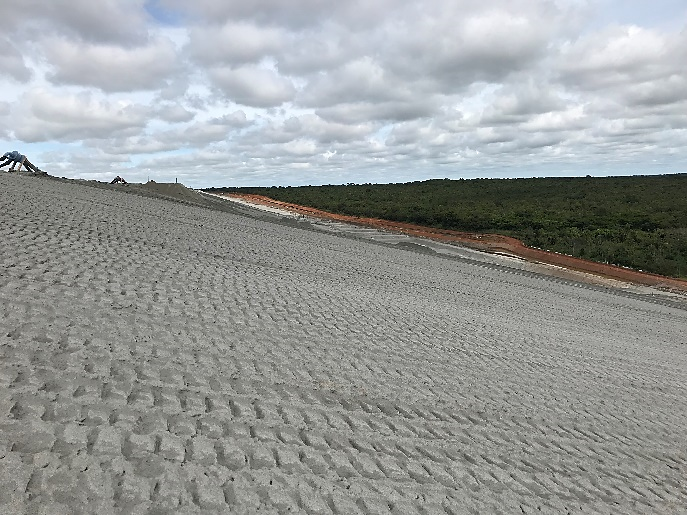Tailings Management
Surface tailings impoundments can represent some of the most significant safety and environmental related risks for the mining industry. Lundin Mining takes considerable care to ensure our tailings facilities have robust and resilient designs, built in accordance with leading industry practices and standards, well operated and maintained, inspected, independently reviewed, and carefully monitored.

Policies and Standards
Lundin Mining’s Responsible Mining Policy and Responsible Mining Management System (RMMS) include tailings specific principles and standards. All Lundin Mining’s operations manage their tailings in accordance with the Tailings Management Standard, updated in 2021 to align to the Global Industry Standard on Tailings Management (GISTM).
The Tailings Management Standard requires that for all tailings facilities throughout the entire lifecycle, from planning and design, construction, operation, closure, and post-closure, implementation of leading practices will be carried out to:
- Protect the health and safety of our people and host communities;
- Minimize harm to the environment;
- Ensure all aspects comply with Lundin Mining policies and standards and accepted international practice;
- Ensure all aspects comply with commitments to stakeholders; and
- Ensure leadership, personal commitment, and accountability from all employees, consultants, and contractors is embedded throughout all aspects of tailings management.
Goverance
Lundin Mining’s oversight of all tailings facilities includes a three lines model. The first line starts with the operational management and engineering teams at the sites which includes a Responsible Tailings Facility Engineer.
At the corporate level, Lundin Mining has a specialized tailings team, which serves as a dedicated technical resource for the site operators and engineers and serves as the second line. The corporate team does not have day-to-day operating pressures and exists to provide assurance and technical leadership related to tailings management.
For assurance, the corporate team manages the Independent Tailings Review Board (ITRB) program and works closely with the sites and external Engineers of Records to make sure any recommended actions are completed in a timely manner. This team develops guidance and tools that support consistent implementation of the Tailings Management Standard across the company. The team also stays abreast of current and emerging technologies and leading international practices around tailings facility design and management. The corporate team provides advice to the sites and supports the Accountable Executive by communicating on assurance activities and any findings as well as preparing Board materials.
As a third line, the corporate team arranges audits to verify consistent implementation and conformance with the Tailings Management Standard including the relevant management systems to assure effectiveness.
Monitoring and Surveillance
A requirement of the Tailings Management Standard is for all operations to conduct regular geotechnical, hydrogeological, and environmental monitoring to meet regulatory requirements and prevent the uncontrolled release of tailings and/or water to the environment.
All operations employ monitoring and surveillance systems which may include surface prisms, piezometers, inclinometers, remote sensing and other technologies to monitor tailings dams and water levels. Trigger action response plans (TARPs) provide clear guidance on how to respond to pre-determined trigger levels for surveillance activities.
All tailings facilities have a closure plan which includes long-term monitoring requirements. The monitoring plan for the closed Ojos del Salado tailings facilities at the Candelaria Mining Complex was reviewed in 2021 and additional dam safety instrumentation was installed.
Responsible Tailings Facility Engineer
All operations are required to identify a responsible person to ensure ownership and proper management of the tailings facility. The Responsible Tailings Facility Engineer (RTFE) ensures procedures for each facility, including an Operating, Maintenance, and Surveillance (OMS) Manual and Emergency Preparedness and Response Plan, are regularly documented, and made available to operations personnel. The responsible person is an appropriately qualified, experienced, and site-dedicated individual employed directly by the operation.
Staff Inspections
Tailings dams are regularly inspected by trained operators and technical staff, sometimes as frequently as several times daily, with formal documented staff inspections at least quarterly.
Engineer of Record
Each tailings facility has an appropriately qualified, licensed, and experienced third-party geotechnical engineer to act as an Engineer of Record in the relative jurisdiction.
Dam Safety Inspections and Performance Reviews
Formal dam safety inspections are conducted at least annually by the Engineer of Record, and reports are issued to the RTFE for action on recommendations.
Dam Safety Reviews
Independent dam safety reviews are conducted by qualified multi-disciplinary technical specialists as frequently as every five years.
Independent Tailings Review Boards
Lundin Mining’s Tailings Management Standard includes a requirement for regular independent third-party tailings review boards, which are recognized as a leading practice for effective tailings management.
ITRBs were established for all tailings facilities in 2022. In addition to the annual site visit, online progress meetings with the ITRBs and Engineer of Record are completed throughout the year to closely track progress made on outstanding recommendations.


